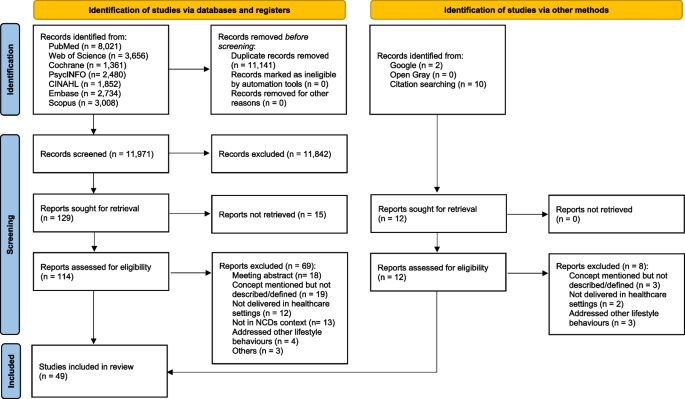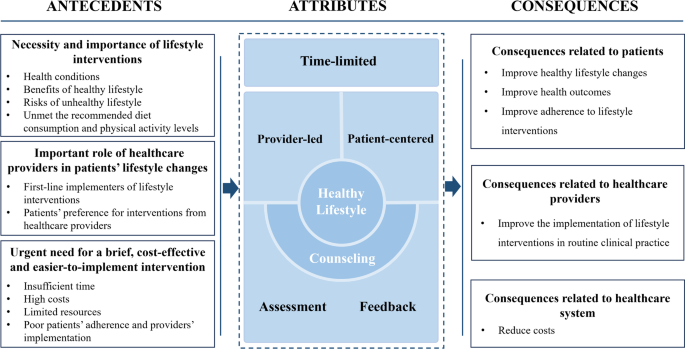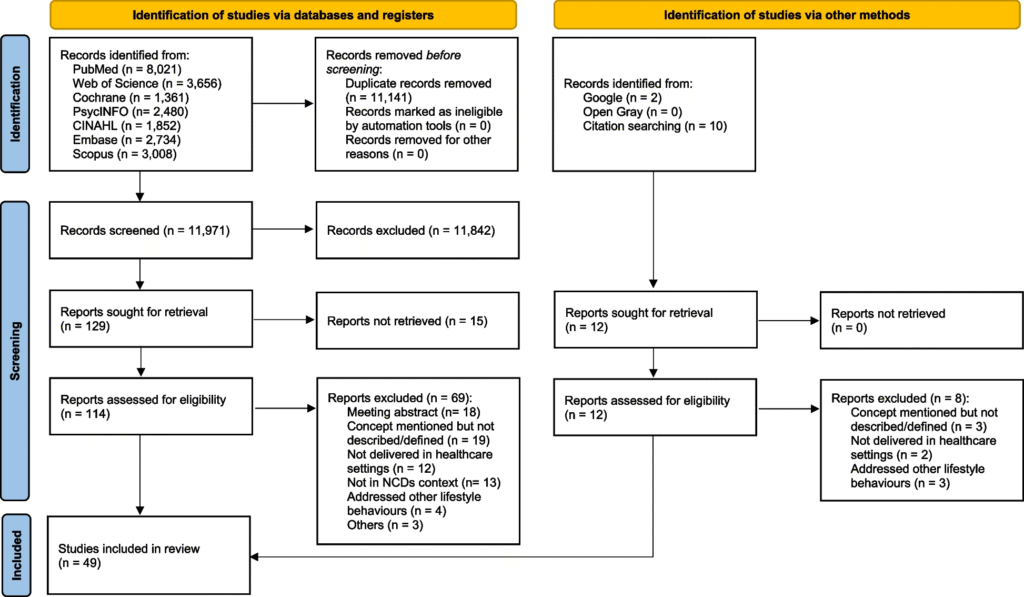Study selection
The initial search yielded 23,124 articles, of which 23,112 were identified from the bibliographic databases and 12 were identified in Google Scholar and citation searching. After the three-step screening process, we finally excluded 23,075 articles and included 49 articles for this concept analysis. Figure 1 illustrates the data selection process using the PRISMA flow diagram.

PRISMA literature search flowchart
Characteristics of the included studies
Forty-nine studies included in this analysis were published between 1996 and 2023. The included studies were conducted in the following countries: United Kingdom (n = 17), United States (n = 11), Australia (n = 9), Canada (n = 2), Mexico (n = 2), and one each in the Republic of Trinidad and Tobago, Italy, Germany, Japan, New Zealand, Brazil, China and Thailand. The study designs were mainly quantitative (n = 35), with 2 qualitative studies, 5 mixed studies and 7 reviews. The details are presented in Additional file 2.
Uses of the concept
The term “brief lifestyle intervention” has not been consistently described in the literature. Lamming et al. (21)defined a brief lifestyle intervention as one lasting no more than 30 min or consisting of a single consultation, aimed at activating an individual’s personal motivation for lifestyle changes. In contrast, Whatnall et al. (17) described it as any intervention that intentionally limits the number and duration of contacts, with the goal of assisting patients in making sustainable lifestyle changes. Based on the definition of “brief advice” proposed by National Institute for Health and Care Excellence (NICE) (32), Gc et al. (33) and Green et al. (34) defined “brief lifestyle intervention” as the provision of advice, discussion, negotiation or encouragement to promote healthy lifestyle behaviors among patients in primary care and community settings. These interventions are typically delivered face-to-face by healthcare providers, with or without supplementary written materials, ranging from a single short session (5–30 min) to multiple brief sessions or follow-ups. Overall, brief lifestyle interventions are generally identified based on their purpose and duration, but there are ambiguities regarding their form and process.
Defining attributes
Determining the defining attributes of a concept is a core step in its clarification and refinement, which leads to a profound comprehension of the concept and its distinctiveness from other concepts (23, 35). This study identified seven defining attributes of brief lifestyle interventions across five aspects: focus, participants, form, process and characteristic of the intervention (see Additional file 2).
Focus: healthy lifestyle
All 49 studies identified “healthy lifestyle” as the central focus of brief lifestyle interventions. A healthy lifestyle, typically encompassing healthy diet and physical activity, plays a crucial role in the prevention and management of NCDs (36, 37), which is in accordance with the recommendations of the World Health Organization (WHO) (38). Brief lifestyle interventions serve as a strategy to enhance patients’ knowledge and motivation for dietary and physical activity behavior change, with the ultimate goal of encouraging the adoption and maintenance of healthy eating and exercise habits (36, 39,40,41,42), thereby contributing to improved overall well-being (43,44,45,46).
Participants: healthcare providers and patients
A total of 41 studies described brief lifestyle interventions as “provider-led”, while 39 referred to them as “patient-centered”. Brief lifestyle interventions emphasize the active interaction between healthcare providers and patients, advocating a “provider-led and patient-centered” care philosophy. This could be interpreted that healthcare providers act as navigators in the intervention and deliver tailored strategies based on patients’ stage of change (30, 47,48,49). The Transtheoretical Model (TTM), the most frequently utilized theory in the included studies, explains behavior change as a process that progresses through five stages: precontemplation, contemplation, preparation, action and maintenance (50). The model also emphasizes that individuals in different stages have distinct needs and highlights the importance of personalized intervention strategies.
Form: counseling
Forty-two studies mentioned that brief lifestyle interventions are delivered in the form of “counseling”, a purposeful conversation designed to empower patients to resolve their lifestyle issues and achieve overall health goals (51). The counseling can vary from basic advice to a more extended, individually focused discussion and is typically conducted face-to-face (21, 46, 52, 53). Additionally, computer-based online brief lifestyle interventions are gradually emerging as an alternative (54, 55).
Process: assessment and feedback
Twenty-six studies identified both “assessment” and “feedback” as essential components of brief lifestyle interventions. The assessment consists of two parts. At the beginning of the intervention, there is an evaluation of patients’ dietary and exercise habits over a specific period to identify whether they align with recommendations for a healthy lifestyle (36, 56,57,58). Meanwhile, a continuous dynamic assessment is also required to judge patients’ stage of change throughout the entire intervention (43, 55, 59).
Feedback in brief lifestyle interventions is a patient-centered discussion based on the assessment results. The emphasis of feedback varies depending on patients’ stage of change (43, 45, 59,60,61,62). For those in the precontemplation stage, the primary objective is to raise their awareness of what constitutes a healthy lifestyle and to create discrepancies between their actions and knowledge (14, 31, 41, 54, 63,64,65). For those in the contemplation stage, the goal is to foster their motivation to embrace a healthy lifestyle. Healthcare providers are required to resolve patients’ ambivalence by assisting them in exploring beliefs about lifestyles and health, weighing the rewards and risks of unhealthy lifestyle, and identifying existing or potential barriers along with possible solutions (40, 45, 58, 60, 66, 67). And for patients in the preparation/action stage, the focus shifts to formulating a personalized plan based on patients’ preferences, allocating resources and proceeding with implementation (34, 66, 68,69,70,71). In the maintenance stage, the emphasis is to reinforce success by offering praise, encouraging continued adherence to healthy habits and motivating patients to pursue further improvement (22).
In addition to the TTM, some researchers have adopted the 5A model (Ask, Advise, Assess, Assist, Arrange) and the 5R model (Relevance, Risks, Rewards, Roadblocks, Repetition) to deliver more structured interventions that can be easily integrated into routine clinical practice (31, 70).
Characteristic: time-limited
Forty-four studies characterized brief lifestyle interventions as “time-limited”, aiming to attain substantial and lasting impact with minimal input and contact (17). These interventions typically last less than 15 min per session and may occur either as a single encounter or over multiple sessions (usually fewer than 5 sessions), with or without subsequent follow-up (44, 57, 60, 61).
Cases
Model case
Sarah, a 50-year-old woman diagnosed with diabetes, sought help for medication-related issues at hospital. Following the medical consultation, the healthcare provider delivered a brief lifestyle intervention for her based on the 5A and the 5R model.
Initially, the provider asked Sarah several questions to evaluate her dietary pattern and physical activity level over the past month. Her answer revealed a diet high in saturated fats and a lack of regular exercise, accompanied by an unawareness of the need for change. The provider determined that she was in the precontemplation stage guided by the TTM. So he advised Sarah on the benefits of a healthy lifestyle to create discrepancies between her actions and knowledge. Subsequently, the provider assessed Sarah’s readiness to change but Sarah said she was still uncertain. Therefore, the provider conducted a motivational intervention by guiding her to explore the relevance of lifestyle choices to her health, weigh the risks and benefits of these habits, and identify existing or potential barriers and solutions to enhance her motivation for change. Following this, the provider repeated the assessment of readiness again and found that Sarah progressed to the preparation stage, willing to improve her lifestyle. And then the provider assisted Sarah in setting achievable and suitable goals for a healthy diet and regular exercise and encouraged her to take small and sustainable steps. The intervention concluded with an arrangement for a follow-up after a month to monitor progress and provide ongoing support in Sarah’s journey toward a healthier lifestyle. The counseling lasted approximately 10 min.
Contrary case
John, a 55-year-old patient with hyperlipidemia, expressed a desire to improve his overall health in the medical consultation. However, the healthcare provider only conducted a routine check-up and neglected to assess John’s dietary pattern and physical activity level. Additionally, the provider didn’t take John’s specific needs and preferences into consideration and delivered a generic, one-size-fits-all lecture on the importance of a healthy lifestyle. Moreover, the conversation lasted about 2 h.
Antecedents
Necessity and importance of lifestyle interventions
NCDs, as the leading cause of mortality, present a significant global health challenge (14, 15, 65). Unhealthy lifestyle behaviors, including unhealthy diets and physical inactivity, significantly contribute to the burden of NCDs (37, 45, 56, 59, 64). Although there is substantial evidence demonstrating the health benefits of adopting a healthy lifestyle (34, 61, 68, 72,73,74), a considerable number of individuals fail to meet the recommended dietary and physical activity levels outlined in the guidelines (42, 44, 62, 75, 76). Therefore, it is crucial to carry out lifestyle interventions to promote a healthy lifestyle in populations at risk or already affected by NCDs.
Important role of healthcare providers in patients’ lifestyle changes
Healthcare providers play a pivotal role in facilitating patients’ lifestyle changes and are recognized as the primary implementers of lifestyle interventions in guidelines (32, 75). Meanwhile, a significant majority of patients, ranging from 80 to 95%, express a preference for receiving guidance on healthy diet and physical activity directly from healthcare providers (36, 43, 59). These findings underscore the central role of healthcare providers in influencing and guiding patients toward positive lifestyle modifications.
Urgent need for a brief, cost-effective and easier-to-implement intervention
However, healthcare providers often encounter challenges in delivering lifestyle interventions, including insufficient time (30, 36, 48, 55, 59), high costs (14, 15, 21, 42, 60, 76), limited resources (30, 55) and poor patient adherence to interventions (13). Consequently, there is an urgent need for a brief, cost-effective and easier-to-implement intervention to address these barriers and enhance the feasibility and effectiveness of lifestyle interventions in healthcare settings.
Consequences
Consequences related to patients
Investigations into patient-related consequences indicated that brief lifestyle interventions can effectively facilitate positive changes in patients’ healthy lifestyle behaviors, including increased intake of fruit and vegetables and higher levels of physical activity (17, 30, 44, 48). Furthermore, brief lifestyle interventions can make favorable effects on some health outcomes in the longer-term, including BMI, waist circumference, blood pressure, glucose tolerance and serum lipids (13, 15, 48, 54, 69, 77). Additionally, brief lifestyle interventions have proven effective in improving patients’ adherence to the intervention due to their personalized nature (13, 74).
Consequences related to healthcare providers
Brief lifestyle interventions provide a practical and streamlined approach for healthcare providers to facilitate the delivery of lifestyle interventions (30, 62). They report that brief lifestyle interventions are feasible and acceptable, with strong potential for integration into routine clinical practice (30, 46, 55, 76).
Consequences related to healthcare system
Limited resources have elevated the importance of cost-effectiveness in decision-making for care programs. Indeed, the cost-effectiveness analysis has become a crucial index for prioritizing plans within the healthcare system (78). According to the included studies, one of the most important consequences associated with healthcare system is the reduction in costs (49, 73), with approximately 50% lower costs compared to traditional lifestyle interventions, including session cost, annual cost and cost per participant annually (60).
Related concepts
From the included articles, four terms that are used interchangeably with “brief lifestyle intervention” were identified: “brief lifestyle counseling” (66, 71), “brief lifestyle advice” (39, 52), “brief lifestyle motivational interview” (45, 68) and “lifestyle prescription” (33, 36). Table 1 highlights the attributes shared with “brief lifestyle intervention”.
Brief lifestyle counseling
Brief lifestyle counseling is defined as a counseling intervention delivered by physicians or other professionals in a circumscribed time frame, aiming to promote lifestyle behavior changes (79).
Brief lifestyle advice
The term “brief lifestyle advice” refers to verbal advice, discussion, negotiation or encouragement provided by commissioners of health services to facilitate patients’ lifestyle modifications, with or without written or other support or follow-up. It can vary from basic advice to a more extended, individually focused discussion (32).
Brief lifestyle motivational interview
Brief lifestyle motivational interview is defined as a tool used in short appointment (approximately 15 min) by healthcare providers to help clients/patients increase both their desire to change and their belief in adopting a healthy lifestyle (68).
Lifestyle prescription
Lifestyle prescription is an evidence-based, achievable, specific written action plan for a healthy lifestyle, provided by healthcare providers and tailored to an individual’s unique needs (80).
Definition of the concept
Based on the analysis of literature, the following theoretical definition of brief lifestyle interventions in the NCDs context was developed:
Brief lifestyle intervention is a time-limited counseling approach advocating a “provider-led and patient-centered” care philosophy, designed to empower individuals to adopt and maintain a healthy lifestyle through assessment and feedback.
A preliminary conceptual model of the term “brief lifestyle intervention”, including the theoretical relationship between its antecedents, defining attributes and consequences is shown in Fig. 2.

Conceptual model of brief lifestyle intervention
Additionally, healthcare providers (nutritionists, exercise physiologists and endocrinologists) and patients (patients with diabetes/obesity or unhealthy lifestyle behaviors) actively participated in developing the universal definition, conceptual model and model case to ensure that the results met their needs.



